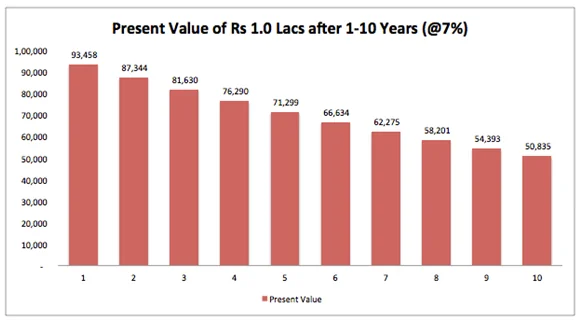Can you buy the same amount (value) of things for Rs 1000, that you were able to buy 5 years back? The answer is surely going to be a big ‘No’. After all, prices of almost everything are rising every year. This is what is generally referred to as the effect of inflation. On a similar note, a Rupee today is worth more than a rupee in the future. Isn’t it?
On a similar note, a Rupee today is worth more than a rupee in the future. Isn’t it?
It is because you can take a rupee today and earn interest/dividends/etc. on it. So it takes more than a rupee in the future, to equal a rupee today.
The Concept of Time Value of Money

The concept of the time value of money is based on the principle that a sum of money available today is worth more than the same amount in the future due to its potential earning capacity. This concept recognizes that money has a time-dependent value, where a dollar received today can be invested or earn interest, increasing its value over time. Conversely, a dollar received in the future is worth less because it has not had the opportunity to earn returns. Understanding the time value of money is essential for financial decision-making, as it helps individuals and businesses evaluate investments, loans, and other financial opportunities by considering the impact of time on the value of money. By applying this concept, individuals can make informed choices to maximize the value of their financial resources over time.
The money available today is worth more than the same amount in the future, due to its potential earning capacity.
How to Calculate the Time Value of Money
The time value of money can be calculated using various financial formulas and concepts. One common method is to use the present value (PV) and future value (FV) formulas. To calculate the present value of a future sum of money, you can use the formula PV = FV / (1 + r)^n, where PV is the present value, FV is the future value, r is the interest rate or discount rate, and n is the number of periods. Conversely, to calculate the future value of a present sum of money, you can use the formula FV = PV * (1 + r)^n. These formulas help determine the worth of money at different points in time, considering factors like interest rates, compounding periods, and the time horizon involved. Additionally, financial tools such as spreadsheets or online calculators can also be used to simplify the calculation of the time value of money for various financial scenarios.
Now within this idea of the Time Value of Money, there are 2 important terms that everyone must be familiar with:
The Concept of Present Value (PV)
To explain this concept with real-life example, let’s take an example. Suppose you have two very simple options in front of you:
Option 1: Get Rs 1000 today
Option 2: Get Rs 1000 after 1 year
Now think about it. Why exactly is the 1st option better?
Of course, waiting for a year to get the same amount doesn’t make sense. But the real point is that you can take Rs 1000 today and generate income from it.
So had you been compensated (monetarily) for waiting a year, say by giving you Rs 1100 after one year, going for 2nd option would have made sense.
This is the concept of Present Value.
Mathematically speaking, the formula for Present Value is:
Present Value = Future Amount / (1 + Annual Interest Rate)^(No. of Years)

The next term to become familiar with is “Future Value.”
The Concept of Future Value (FV)
This is easier to understand. It is the future worth of an amount that is invested today.
So if you invest Rs 1000 for one year at 8%, then the future value of the investment is Rs 1080. The mathematical formula is as follows:
Future Value = Present Amount x (1 + Annual Interest Rate)^(No. of Years)
The concept of future value is used a lot when you invest some money for the future and ask about how much you will be getting after a given period. At that point, you are actually referring to the Future value of your investment.

Like compounding, most people do not give importance to understanding the concept of the time value of money. But that’s a mistake. If you don’t understand this concept, you end up making wrong financial decisions about your money and investments.
A simple thumb rule to help you remember the concept of the time value of money is:
The value of a Rupee yesterday was more than that of a rupee today. But the value of a rupee tomorrow will be less than that of a rupee today.
Visit Tradejini to learn more about other financial terms and concepts.



